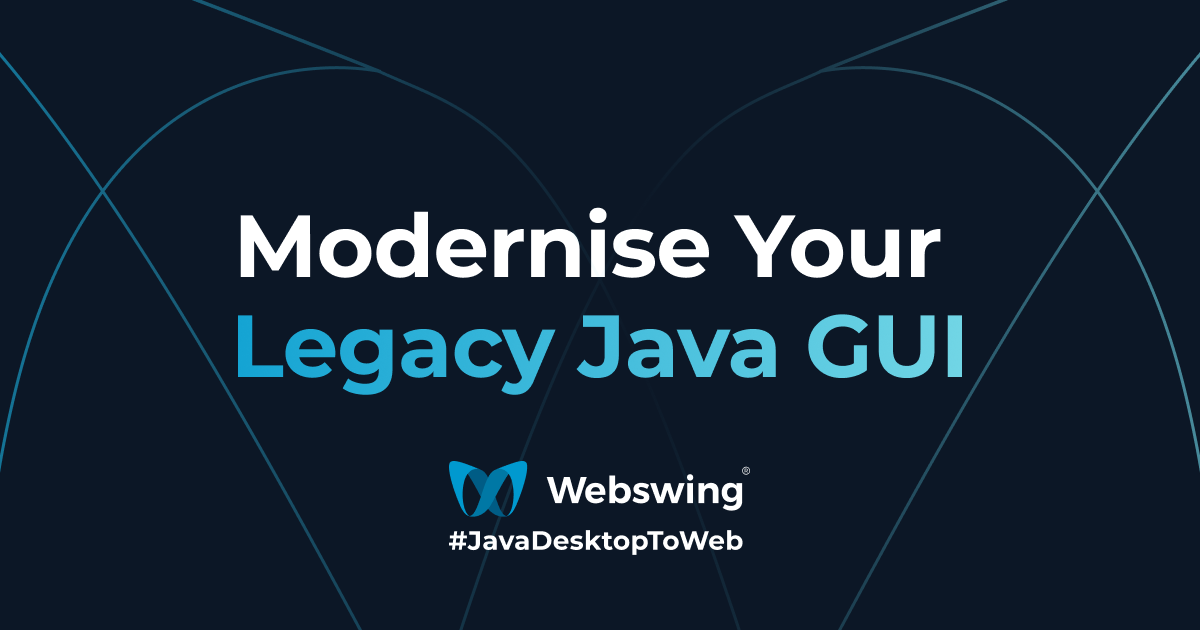Still running a Java Swing, JavaFX, SWT or Netbeans app? Learn how to modernise without rewriting - using Webswing to deliver your legacy GUI app in the browser.
Rewriting your Java desktop app (Swing, JavaFX, Eclipse(SWT) or Netbeans) from scratch sounds bold, until you hit the budget, timeline, and business risks. If your app still works, but the delivery model is stuck in the past, Webswing is your way forward.
Let’s be honest: Your Java app still works, but the world moved on
You built a Java desktop app years ago. Maybe in Swing, Eclipse (SWT), maybe even JavaFX or Netbeans.
It runs fine. Your team knows it. It handles real business logic. Clients use it every day. But the way it’s deployed? That’s the problem.
Your users expect browser access. Your IT team is tired of managing Java runtimes. Web Start is gone. Security departments are breathing down your neck. The app’s not broken - but it’s stuck.
And now someone says: “Let’s just rewrite it in Angular.”

Why rewriting sounds good only until you do the math
Starting over sounds tempting. New UI, clean codebase, trendy tech stack, no further tech debt.
Until you realise:
- It’ll take months or even years to rewrite
- You’ll lose years of stable business logic
- QA will have to start from scratch
- You’ll miss deadlines, and users might potentially hate the new version
- While development process is running you maintain 2 codebases
Meanwhile, your current app already solves pretty much everything what’s needed. If only people could access it more easily.
There’s a better way: Keep the app. Change the delivery.
This is where Webswing comes in. You don’t touch your source code. You don’t refactor the UI. You simply run the app in a browser, instantly giving it new life.
Webswing “wraps” your Java app and delivers it through the browser - no plugins, no applets, no client-side Java. Just modern, HTML5-based access. Same app. Zero rewrite. Infinite upgrade options.
What changes when you put your Java GUI in the browser
The moment your app runs in a browser, a lot gets easier:
- 🔒 Protects your application’s codebase
- 🚀 Simple distribution of application updates
- 🎯 Control over Java runtime version
- 🔐 No client-side Java required = reduced security risks
- 🌐 Faster backend connections (no VPNs or local installs)
- 🎫 Centralised user access and session management
- ☁️ Infrastructure agnostic – run it on your own hardware, cloud, containers, or VMs
- 🌍 Browser agnostic – runs in all modern browsers
- 🧱 Framework agnostic – integrate with any frontend web framework when needed
- ☕ JVM agnostic – supports Java 8, 11, 17, and 21, and works with OpenJDK
The point isn’t just convenience - it’s modernization by evolution, not revolution.
What about the UI? Yes, You can improve that too
Running in the browser doesn’t mean you’re stuck with your old graphics forever.
Once you’ve stabilised delivery, you can step into a new modernisation process with Webswing Modernisation Framework. After you Web-enabled your application you can then further Extend it, Facelift it or decide for deeper and continuous step-by-step Rebuild. Each approach has a different impact on your business regarding effort and complexity, impact on business logic, remaining tech debt or other development limitations. But you can freely combine multiple approaches in order to get:
- Instant access to your app via browser and unified deployment
- Single codebase - not splitting the application
- Gradual change
- Best user adoption rate
And most importantly, you do it on your terms, without breaking things that already work.
Real teams did this and it worked for them. We’ve seen large enterprise clients from different industries modernise critical legacy java desktop apps this way. Either way you decide to modernise your application with Webswing and Webswing Modernisation Framework, it’s surely the most meaningful way of getting rid of your tech debt on the market now.
Your Java desktop app has years of trust, battle-tested workflows, and satisfied users. Don’t throw that away just to look “modern.” Legacy doesn’t mean broken and modernisation isn’t all about full rewrite. It’s about rethinking how your app lives in the world for your users.
And Webswing gives you the simplest, safest way to take that first step with zero disruption.

